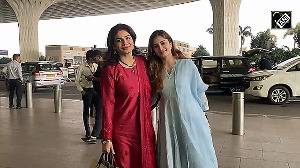This slick mobile handset is special. It has a long battery life -- over eight and a half hours of talk time, nearly three times more than most other handsets in town.
This phone also offers the simple pleasures in life -- downloading ring tones, instructions in Hindi as well as in English, to name two. It has other advantages too.
It has a stand by battery time of two weeks, in case you have forgotten to recharge it. And you can buy it at a store near you or from your mobile service company at the low price of under Rs 2,000 a piece, making it one of the cheapest mobile phones ever to hit the Indian market.
The phone is made by Motorola, which is set to unveil its sub-$ 40 (Rs 1,657, at last week's exchange rate) mobile phones from April in emerging markets across the globe. Motorola's big stop will be India. With three entry level models (C 115, 116 and 117), the GSMA expects the US telecom company to hawk 2 million to 3 million sets in India in the first six months of the launch.
Says Percy Batlivala, general manager, east south Asia, at Motorola's personal communications business: "Over 70 per cent of global system for mobile customers use phones which cost below $65 (Rs 2,732). The low cost phone will help to open a new market."
The demand for the phone here has been overwhelming -- and not enough handsets may be rolled out at Motorola's plant in China.
Says Ben Soppitt, commercial director of the GSM Association, which represents the interests of GSM mobile phone service companies around the world: "Earlier our target with Motorola was to sell six million of these phones globally in six months. We will easily exceed 10 million. Virtually every operator in India wants to buy the phone and 2 -3 million can easily be sold here. As the supply is limited, we will distribute the phone according to the market share of operators."
Motorola's phone will be the first of several inexpensive phones that are expected to hit India this year and make phones affordable to the masses. Mobile phone makers expect that their initiative will expand the Indian market considerably and take mobile telephony to rural India.
Motorola itself is working on another new phone, which it hopes will bring prices down even further to the sub $30 or Rs 1,309 in India. GSMA hopes prices will tumble even further to as low as $25-20 ( Rs 1090.75- to Rs 873) as sales volumes grow bigger.
To push this, GSMA is planning to float yet another tender by the end of this year for 10 to 20 million more ultra low cost phones, depending on the response.
Says T V Ramachandran, secretary general of the Cellular Operators Association of India: "The whole idea is to get more manufacturers to compete and make low cost phones. That will reduce prices further."
So while Motorola will have a first mover advantage in the ultra low cost phone market, it will quickly face competition. The next GSMA tender is open to anyone, ranging from Chinese manufacturers, Indian start ups to other international telephone majors.
There's more bad news for Motorola. Code division multiple access phone set manufacturers too are gearing up for battle. The US-based Qualcomm is readying to launch a sub $50 (Rs 2,182) phone in the market in April this year.
Says Kanwalinder Singh, president of Qualcomm India: "CDMA operators in India are already offering phones at below $30 in bundles. So what the GSMA is trying to do has already been accomplished." Tata Teleservices, for instance, recently threw in with a connection a Motorola CDMA phone for Rs 1,499.
Singh says that unlike Motorola (which is offering a $40 price to retailers) Qualcomm's $50 will be the price operators will pay. And as most CDMA operators bundle the phone with connections, they give it at a lower price to subscribers.
In the GSM camp, Nokia (whose cheapest model currently is priced at $65 or Rs 2,836) has tied up with Texas Instruments to develop a chip set that will incorporate most of the mobile electronics components necessary for a phone in a single panel.
Says Sanjay Behl, Nokia's head of marketing: "The single chip will provide Nokia mobile phones the ideal mix of cool features and cost effectiveness, making them more attractive to the mass market price."
Even relatively new mobile phone manufacturers like the California-based Hop-On are cocking an eye at the Indian market. A fortnight ago, the company announced that it was launching its 1813 candy bar-style phone for the Indian market, priced at $ 36 (Rs 1,571) if you pick up at least 10,000 phones.
Hop-On CEO Dan Ganon said after the announcement: "India is the second most populated country in the world. Our market research shows a tremendous growth opportunity."
Home-grown MCorp Global (controlled by industrialist B.K Modi) too is jumping into the fray. It hopes to offer entry-level black and white phones (imported from China or Taiwan and later assembled in the company's Himachal Pradesh plant) for Rs 2,000 to Rs 2500 and a colour entry version priced at about Rs 3,000.
Says Kunal Ahuja, CEO, Mobile Business, at MCorp Global: "We are following a reverse distribution model. Our aim is to go first to the smaller towns and cities and then to the metros because our market is there. We hope to be in 400 towns in the first phase."
Strikingly, these phones are built to ensure a low failure rate. And both mobile service companies and handset makers are aware that the lower end of the market has different needs.
So apart from the three phones now on offer, GSMA executives say in the works are phones with no display, with only voice and text and with only voice -- all of which can further reduce costs.
What precisely explains the rush to launch low cost phones? Behl says that with operators now extending their coverage from the existing 2,800 towns to 5,000 towns where people will be connected by mobile phone services for the first time, cheap phones will be in demand.
According to the COAI, only about 25 per cent of the population (that is, 250 million) have wireless coverage but 75 per cent still cannot afford a phone. That market is waiting to be tapped.
In the next phase half of the country (500 million) will be covered by wireless phone services and the incremental 250 million potential customers will also look for a low entry cost phone.
That is why GSMA, Motorola and mobile service companies are looking at ways of making mobile services affordable. Phone manufacturers are trying to persuade mobile service companies to bundle phones with an attractive entry-level tariff. Indeed, once handset prices fall below $30 (Rs 1,309) the more aggressive mobile service companies could even offer the phone free to subscribers (that is, provide a phone subsidy).
Still, some issues have to be tackled first. The cost of the bundled phone under present laws is added to the mobile service companies' revenue and so they have to pay a percentage of this by way of revenue share to the government.
Says Ramachandran: "It is a double tax on the phone. We are taking this up as it could be an impediment to market growth."
At the moment mobile service companies have two options of getting around the problem they can set up a separate company, which will buy the phones and then offer them to the operating company or they can pick the phones up from distributors (who have to paid a margin, thereby increasing costs).
Yet the big question is whether the big phone manufacturers are misreading the market. With handset buyers increasingly shifting to colour phones whose prices are falling, does a market for black and white phones exist at all?
Argues K R Kim, managing director of LG Electronics India (which is steering clear from the ultra low handset segment): "Look what happened to the black and white TV. The same thing will happen in mobile phones. Customers will only want colour phones whose prices will fall dramatically."
That view is echoed among other phone producers like Sony Ericsson, which point out that nearly half the phones sold currently in the market are colour handsets.
Says Sudhin Mathur, general manager at Sony Ericsson in India: "The price differential between a colour and a black and white phone is falling and is as low as Rs 500-700. And we already have colour phones with a speakerphone and other features at below Rs 4,000."
Even so, most other big handset companies are not willing to ignore the large potential for volumes. Nokia is looking at ways to reduce the per user cost of acquisition -- the aim is to make it possible for mobile service companies to make money even at an average revenue per user of $5 (Rs 219) and below a month, by ensuring a right mix of phones, optimised networks and services.
So Nokia has developed an e-fill option -- subscribers to pre-paid services will be able to refill their talk time through the phone by paying dealers sums of less that $1 (Rs 43.63) (the cost of printing slips is saved -- the slips are not viable at such low denominations).
It has also developed networks that offer better coverage in remote areas and higher capacity networks that do not involve additional investment.
Qualcomm, on the other hand, is concentrating on chip set development. Earlier, the radio frequency had to be built by using separate components and putting them together. The company now has integrated all the components into one chipset. Singh says this reduces bill for materials, reduces the board space for the platform and cuts production time.
Meanwhile, the GSM Association set itself an ambitious global target at its meeting in Cannes -- it wants to reach the over 3.3 billion potential customers across the globe who do not have a mobile phone or cannot afford it, a large chunk of them in India. That's laudable.
The question, however, is whether it's making the right call by pushing black and white handsets. For an answer, watch this space in about a year.
A global solution
Just six months ago mobile service companies from emerging markets voiced a serious concern at meetings in Cannes under the aegis of the GSM Association. They wanted to expand the market but were facing a serious challenge -- reducing the cost of entry for customers.
GSMA conducted research and discovered that the biggest barrier was the cost of mobile phones. It then roped in nine mobile service companies -- Bharti Tele-Ventures in India, Globe Telecom in the Philippines, Singapore Telecom, Maxis in Malaysia, Turkcell in Turkey and Shinwatra in Thailand, to name a few.
They arrived at a unique solution: they would float a global tender for an ultra low cost good quality phone. The nine mobile service companies would initially commit themselves to buying a large quantity of phones from the winner of the tender, so that the handset manufacturer could take advantage of the volumes and drive down the phone's cost.
Motorola won the tender and produced a new low cost phone, the C117. Says GSMA commercial director Ben Soppitt: "As many as 18 vendors participated in the tender. By offering a single specification and large volumes, Motorola could ensure that it would drive its costs down substantially."






 © 2025
© 2025